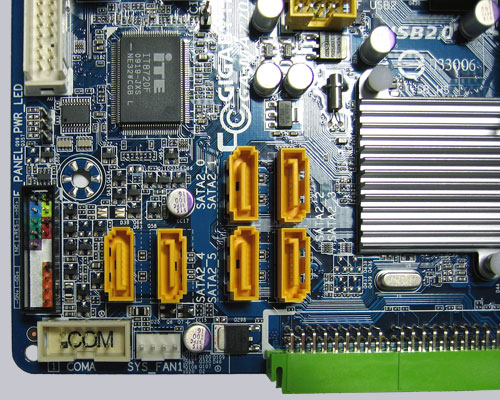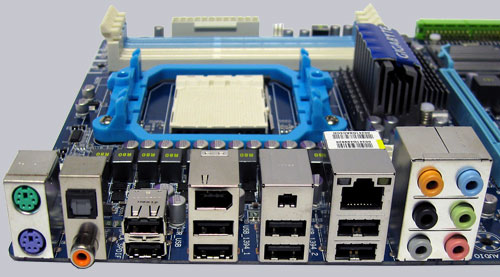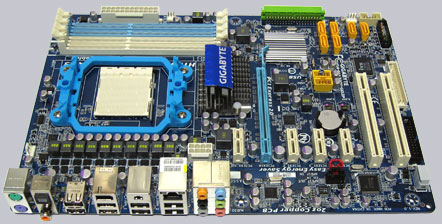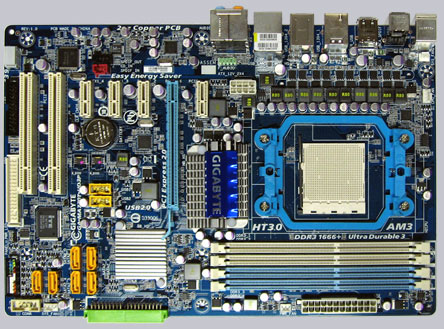
Result and general impression

++++ The Gigabyte GA-MA770T-UD3P motherboard has a price of approx. 75 Euro (08/2009) and is thus in the lower price segment of the Socket AM3 DDR3 motherboards.
The new Gigabyte GA-MA770T-UD3P motherboard is build with the AMD 770 chipset and the SB710 southbridgeand is on ocinside.de the first AMD DDR3 board. It is in the lower price segment, but it has awesome settings and a nice overclocking result. The review will show how high the performance and the overclocking of the Gigabyte MA770T-UD3P is in comparison to the previous Socket AM3 DDR2 board.
Here is a first look to the Gigabyte cardboard box which already presents some features of the AMD 770 motherboard like e.g. the two OZ copper layer as ground and power layer between the data layers to reduce the temperature and the more durable solid capacitors:
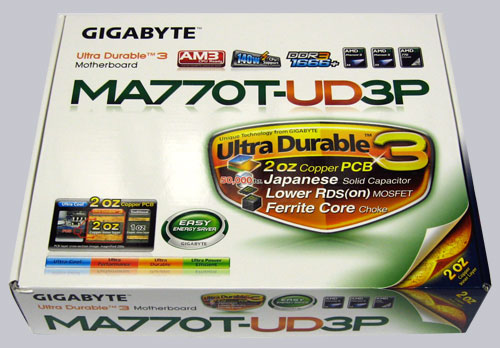
Equipment and other features …
Gigabyte’s GA-MA770T-UD3P motherboard comes with three manuals, one DVD, one IDE cable, two SATA data cables, one ATX I/O panel and one Gigabyte sticker.
Expansion cards …
This board offers beside one x16 PCI Express 2.0 video card slot four additional x1 PCIe Slots and two PCI Slots for conventional expansion cards. The amount of PCI Express Slots is amazing and offers thus very good upgrade possiblities for new PCIe expansion cards.
Memory …
The Gigabyte GA-MA770T-UD3P board can be equipped with up to four DDR3 memory modules and is upgradeable up to 16 GB memory. The total amount depends on the operating system used (list).
The Socket AM3 mainboard supports DDR3 memory modules and can be optimized in the BIOS for DDR3-800, DDR3-1066, DDR3-1333, DDR3-1600 and faster Dual Channel modules. It’s possible to use ECC memory if it is supported by the CPU.
DDR2 module can’t be used on this motherboard, even if the memory controller of the Phenom II processor would support both memory types.
Hard disk drive connectors …
The motherboard offers one IDE connector for maximally two conventional ATA 133 drives and six SATA II ports (3 Gb/s) but without an eSATA-II port. The S-ATA II ports support RAID 0, RAID 1, RAID 10, JBOD.
The manual contains all basic informations to manage a fresh installation of Windows XP or Windows Vista with S-ATA hard disks and how to make a RAID installation. Drivers for Windows XP and Windows Vista are provided on the DVD and can be downloaded on the Gigabyte support page.
Here are the six yellow SATA ports:
And here is more detailed picture of the frontpanel plugs, where Gigabyte placed small symbols for the polarity and colored marks inside of the connector. So it’s easy to find the right cable position also without the motherboard manual:
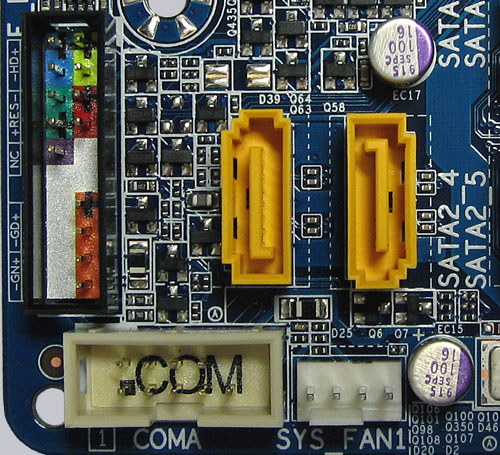
USB and Firewire …
This board has eight USB 2.0 connectors at the I/O-panel and two internal USB 2.0 plugs for up to four optional USB ports and three IEEE1394 firewire ports. The internal firewire port is optional and can be used for example for the front panel of a PC case.
Network …
The Realtek RTL 8111 C/D chip with 10/100/1000 network connector at the ATX panel is integrated on the Gigabyte GA-MA770T-UD3P motherboard.
Serial and parallel port …
This motherboard provide an internal optional serial port and parallel port. An optinal cable kit for the COM and LPT port is available at Gigabyte (12CF1-1CM001-3*R COM und 12CF1-1LP001-0*R LPT).
Sound …
The Gigabyte GA-MA770T-UD3P motherboard is equipped with the ALC 888 Soundchip which supports 7.1 surround sound for example analog over 6x 3.5mm connectors at the ATX panel or over the internal analog connectors.
For the digital output there is one coaxial SPDIF and one optical SPDIF at the I/O panel and an internal SPDIF Out connector and an SPDIF In connector is also available. These sound connection options are also for expert users very amazing.
Here is a picture of the back panel connectors:
From left to right one see the two PS/2 ports for keyboard and mouse, optical SPDIF out, coaxial SPDIF out, 2x USB, IEEE1394 and 2x USB, IEEE1394 and 2x USB, RJ45 Gigabit LAN and 2x USB and 6x 3.5mm connectors for the sound.
The picture shows additionally the flat solid caps for higher stability and better durability of the motherboard. Gigabyte soldered these solid capacitors not only near the CPU, but also on the complete board.
BIOS and Overclocking …
Let us go on with the BIOS options and with the BIOS overclocking. The next picture shows the startup screen and not the motherboard cardboard box. Let us see when manufacturers subsidize motherboards with external advertisement 🙂
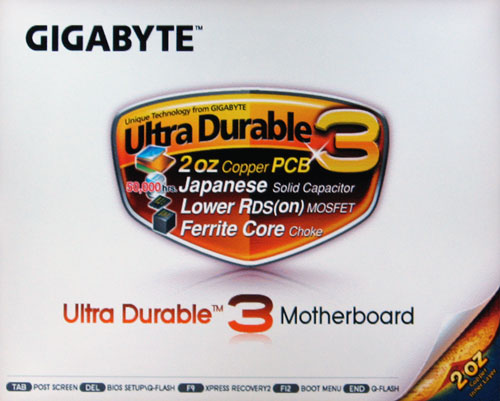
By pressing the delete key while booting up the PC, you get access to the Award BIOS with all important hardware settings. With the key combination CTRL + F1 you get some hidden additional expert settings in the BIOS. For the review the motherboard got the latest BIOS update version F3.
The BIOS offers awesome DDR3 memory settings like e.g. the memory frequency divisor from 4x over 5.33x and 6.66x on up to 8.00x (DDR3 800/1066/1333/1600) and also without pressing the hidden Control and F1 key combination, there is a complete page with timing settings.
Who like to get the best out of the RAM, should find the right timing settings here:
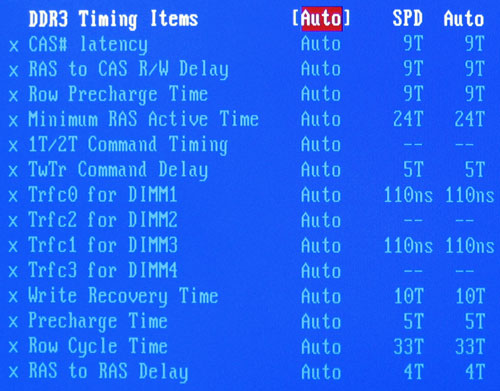
The host clock is adjustable from 200 MHz up to 500 MHz and the HT (hypertransport) divisor is adjustable from 1x to 10x (200-2000 MHz). A lower host frequency setting below 200 MHz is btw. not possible. The PCIe frequency is adjustable from 100 MHz up to 200 MHz and can be clocked asynchronous to the host frequency.
It was possible to reach a very high reference clock of 320 MHz, whereby it was stable up to 310 MHz with default voltage settings. This motherboard overclocking result is not as high as previous tested ASRock A790GXH/128M, but it is nearly the highest OC result.
With too high overclocking values it was necessary to restore the BIOS defaults with the Clear CMOS Jumper, this could be surely solved somewhat better.
However Gigabyte offers a so-called Dual BIOS to restore a correct BIOS version, a Backup BIOS to HDD option, QFlash, Xpress Recovery2 as system backup and many other nice features for more security. Also very positive is the immediate presentation of the frequency for the CPU and the memory in the BIOS menu, as soon as the reference clock is changed in the BIOS screen. So the annoying calculating of the frequency divisor or frequency multiplicators is not necessary.
Another interesting feature is the so-called ACC setting in the BIOS. With the Advanced Clock Calibration feature it was possible to unlock the deactivated fourth core of the AMD Phenom II 710 X3 test CPU.
Tip: The EC Firmware selection have to be set to Hybrid to unlock the 4th core with ACC.
Unfortunately it is not possible with all Phenom II CPUs, but the BIOS option is nevertheless present and this is surely an important purchase aspect for some buyers.
Furthermore, this board offers several voltage settings like for example the CPU NB voltage from -0,600 to +0,600 Volt, a Vcore setting from -0,600 to +0,600 Volt, a SB setting between 1.200 and 1.580 Volt, DDR VTT between 0.900 to 1.300 Volt, NB PCIE between 1.800 and 2.200 Volt and a NB voltage between 1.100 and 1.800 Volt. The DDR3 memory voltage can be set between 1.600 Volt up to very high 2.400 Volt in steps of 0.020 Volt, whereby these high memory voltages should be used with caution also with very good cooling and OC RAM.
The downclocking or underclocking was also tested in this review. It was possible to lower the AMD Phenom II 710 CPU multiplier to 5x over the BIOS and it can be underclocked in such a way with 200 MHz reference clock to approx. 1000 MHz per core.
Also several energy saving options are available on this Gigabyte motherboard. The new GA-MA770T-UD3P board offers the Away Mode, which is particularly very important when using Microsoft Windows MCE (Media Center Edition) to e.g. record TV shows when the PC system is nearly powered off. Furthermore, the AMD C1E provides a smaller power consumption by lowering the frequencies, however with some timing critical applications it is possible to get failures. The current consumption of the test PC with AMD Phenom II 710 X3 CPU, Nvidia GTS250 PCIe 2.0 video card, 4GB DDR3-1333 memory and hard disk drive was between approx. 57 Watts up to 115 Watts without overclocking and depending upon load.
The BIOS of the passive cooled GA-MA770T-UD3P motherboard comes by the way with a smart fan control option for a temperature controlled 4-pin CPU fan.
Last but not least Gigabyte spend the board some interesting software on DVD, like e.g. Easy Tune 6 to simple underclock and overclock the PC in Windows.
Result …
The Gigabyte GA-MA770T-UD3P is based on the AMD770 chipset and is inspite of the small price a first-class motherboard for AMD Socket AM3 processors and DDR3 memory modules.
The equipment of the low-priced motherboard is also very good, because the Gigabyte GA-MA770T-UD3P motherboard offers 7.1 sound with analog and digital output for sound over dozens of sound connectors, up to twelve possible USB ports, up to three IEEE1394 firewire ports, six SATA II ports with RAID support and Gigabit LAN.
Gigabyte’s GA-MA770T-UD3 achieved not the highest overclocking result with 310 MHz reference clock, but so many equipment and these numerous overclocking features with such a favourable price have to be honored with the ocinside.de Overclocking price tip award. Thus the Gigabyte GA-MA770T-UD3P motherboard receives the Redaktion ocinside.de Overclocking pricetip award 08/2009 – nice features for relatively little money !
All in all the Gigabyte MA770T-UD3P motherboard is thus a nice board to enter the world of AMD Socket AM3 CPUs in combination with current DDR3 memory.
Special thanks to Gigabyte for their support.
* All Socket AM2 / AM3 PCIe motherboard reviews since 01.08.2009 are based on an AMD Phenom II 710 X3 CPU, 1x Gigabyte GV-NX66T128VP nVidia 6600 GT PCI Express video card to compare older Benchmark results, 1x Gigabyte GV-N250OC-1GI Nvidia GTS250 PCI Express 2.0 video card, 2x 1024MB Crucial Ballistix Tracer DDR2-1066/PC2-8500 memory modules on DDR2 mainboards or 2x 2048MB Crucial Ballistix Tracer DDR3-1333/PC3-10600 memory modules on DDR3 mainboards, and the following software configuration: Microsoft Windows 7 RC, Microsoft Windows Vista Ultimate, Windows XP SP2, SiSoftware Sandra 2009 SP3, Futuremark 3DMark03, 3DMark06 and 3DMark Vantage (the software is available in the Links & Downloads section). All benchmark results only offer a comparison among themselves for a rough motherboard performance comparison.
Back to the AMD Athlon 64 and AMD Phenom motherboard comparison !


